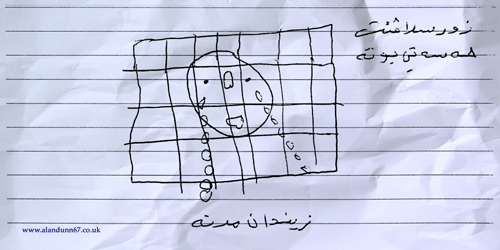
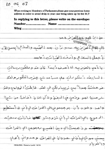
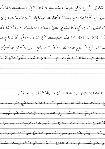
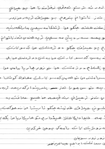
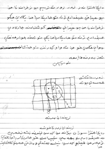
This work is in honour of the courage of the refuges and asylum seekers I have visited in HMP Liverpool (Walton) since 2001, as one of a small group of volunteers, members of AVID (National Association of Visitors to Immigration Detainees). These are not criminals in any sense of the word. They are victims of asylum and immigration legislation now being enacted almost annually in our hostile political climate, and a correspondingly hostile or indifferent local criminal justice system.
Why Liverpool?
Very few of those we visit in the prison come from Liverpool or have lived here before arrest. Nearly all have been arrested or detained at the Immigration Office in Liverpool, one of the only two in the country where asylum applications are processed.
The image
is from a letter by a Kurdish asylum seeker detained in 2003. The letter is written first in Arabic (pp1 & 2), then in Kurdish Kirmanji (pp 3 & 4).
The captions to the drawing are in Kurdish Kirmanji. To right of drawing: “I send you a lot of greeting”. Underneath drawing: “Prison is death. Prison is so bitter”.
The letter in English:
Dear Mum-Sozan,
I send you my greeting.
I don’t know if you received my previous letter or not.
Thank you very much for helping me. I was very happy when you visited me.
I have met the solicitor and I have explained my situation to him. Now I am afraid of sending me back to Iraq because I have got married to a Christian girl and I have converted to Christianity and all my family and my relatives have become my enemy.
Please can you write to me and let me know if there is any news about deportation.
Please let me know if there is any hope of staying here. Please comfort my heart.
Thank you very much. (Signed + prison number).
(At very end of p4, under drawing and caption:
Mum-Sozan, I have nobody here and I hope you could help me. I have got nobody in this country only you. You became everybody for me.)
The Crime
He fled for his life, in a lorry from Iraq. He arrived in UK, in Leeds, in January 2003. He claimed asylum the day he arrived and was given Temporary Admission to the UK. But under Section 55 of the newly enacted Asylum & Immigration Act 2002, which was being interpreted unbelievably harshly, he was denied even basic support. “They told me to sleep in the Park”. After some weeks living rough, occasionally sleeping overnight with Kurds he met in the street, in February he made a second asylum claim in a different name, out of naive desperation, at Liverpool Immigration Office. His fingerprints matched those from the earlier claim. He was arrested and charged with “deception in order to enter or remain in the UK” for which the maximum sentence is 2 years in prison.
The Sentence
He was given duty solicitors who told him to plead guilty. The Magistrates Court committed him to the Crown Court for sentence and remanded him in custody. He heard about us from other immigration prisoners, wrote to us in Arabic, and we began to visit him weekly with a volunteer Kurdish interpreter. He was verbally and physically attacked in prison - quite common with “our” prisoners - leaving him with permanent scars on his left temple and the bridge of his nose. After 3 months he appeared in the Crown Court. By chance, the Judge who sentenced him was the most sympathetic in these cases, always making clear his view that they were not a matter for criminal courts. “You have been in custody for 3 months and 3 days. My sentence will end your custody ... Every week we have before us an increasing number of cases such as yours. The Court of Appeal says I have to send you to prison. Prisons should be for people who are dangerous or seriously dishonest. I do not regard you as one of those people ... I sentence you to 6 months ... Because you will only serve half of that, and you have served 3 months and 3 days already, this sentence should result in your immediate release.” HOWEVER...
Immigration Detention
Unbeknown to the Judge, a person “subject to immigration control” who is taken into criminal custody is simultaneously detained by the immigration service (“Dual Detention”). The prison can only release him on receipt of a paper (IS96) from the immigration service giving Temporary Admission into the UK, on condition that he reside at a specific address and sign at a specified immigration office or police station usually weekly or monthly. In 2003, the immigration service was routinely inefficient and slow in doing this and “our” prisoners were being detained at the end of their sentences for several weeks or months, even when represented by good immigration solicitors. Obviously such detention is extremely stressful, not least because it’s indefinite (Britain is the only country in the EU to allow indefinite detention). Far from being immediately released, as the Judge intended, this man was taken back to prison from the court and detained there. We continued to visit and he wrote many letters. The letter with the drawing was sent when he had been detained for a month. After being detained for 5 weeks, he was released.
What happened next?
For some immigration officer’s typical unreason, he was released to a hostel in Edinburgh, where he had never been, although he had given the address of a refugee in Yorkshire who had helped him when he was living rough. The Scottish Refugee Council kindly helped him to sort this out and go to Yorkshire.
We may now have lost touch with him and do not know if his asylum application was successful at appeal. This is impossible to predict as the whole system is a lottery. Ironically, at about the time he was released, a High Court Judge ruled that S55 of the Asylum and Immigration Act 2002 constituted inhuman and degrading treatment and was thus in breach of Article 3 of the Human Rights Act 1998. The Government appealed, and lost. Meanwhile, the creation of asylum “criminals” has accelerated. This year the Asylum & Immigration Act 2004 has come into force, nastily inventing several little new crimes, at leas5t one of them at complete variance with international Conventions...
Note
I am aware that the use of this letter and drawing may be regarded as criminal in its turn; plagiarism or theft? Acknowledgments and thanks anyway, to the writer of the letter and to Nihad Murad who translated it.
Susan Fitch, June 2005